
Saint Paul is the capital of the U.S. state of Minnesota and the county seat of Ramsey County. Situated on high bluffs overlooking a bend in the Mississippi River, Saint Paul is a regional business hub and the center of Minnesota's government. The Minnesota State Capitol and the state government offices all sit on a hill close to the city's downtown district. One of the oldest cities in Minnesota, Saint Paul has several historic neighborhoods and landmarks, such as the Summit Avenue Neighborhood, the James J. Hill House, and the Cathedral of Saint Paul. Like the adjacent city of Minneapolis, Saint Paul is known for its cold, snowy winters and humid summers.

The Great Northern Railway was an American Class I railroad. Running from Saint Paul, Minnesota, to Seattle, Washington, it was the creation of 19th-century railroad entrepreneur James J. Hill and was developed from the Saint Paul & Pacific Railroad. The Great Northern's route was the northernmost transcontinental railroad route in the U.S.

Saint Paul Union Depot is a historic railroad station and intermodal transit hub in the Lowertown neighborhood of Saint Paul, Minnesota. It serves light rail, intercity rail, intercity bus, and local bus services.
A festival marketplace is a European-style shopping market in the United States. It is an effort to revitalize downtown areas in major US cities begun in the late 20th century.

Cray Plaza, located in the Lowertown neighborhood of Saint Paul, Minnesota, United States, provides space for working, living, eating, and recreating on one square city block opened in 1986.
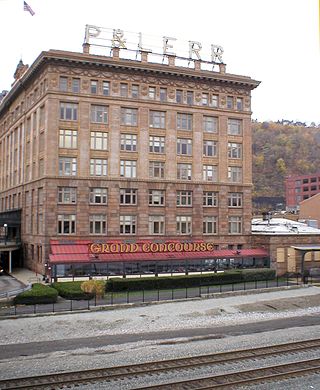
Station Square is a 52-acre (210,000 m2) entertainment complex located in the South Shore neighborhood of Pittsburgh, Pennsylvania, United States across the Monongahela River from the Golden Triangle of downtown Pittsburgh. Station Square occupies the buildings and land formerly occupied by the historic Pittsburgh & Lake Erie Railroad Complex, including the Pittsburgh & Lake Erie Railroad Station, which are separately listed on the National Register of Historic Places.

Saint Anthony Main is an stretch of buildings on Main Street across from Saint Anthony Falls in the Nicollet Island/East Bank neighborhood of Minneapolis. Commonly the area is associated with Northeast, Minneapolis as it is actually northeast of downtown on the east side of the Mississippi River. It opened as a festival marketplace in the 1980s.

Burnsville Center is located in Burnsville, Minnesota. It is one of the larger enclosed malls in Minnesota with 100 stores on 3 floors and approximately 1,100,000 square feet (100,000 m2). The mall opened in 1977 with three anchor stores, Sears, Dayton's, and Powers Dry Goods as anchors.

Minneapolis, officially the City of Minneapolis, is a city in and the county seat of Hennepin County, Minnesota, United States. With a population of 429,954, it is the state's most populous city as of the 2020 census. It occupies both banks of the Mississippi River and adjoins Saint Paul, the state capital of Minnesota. Minneapolis, Saint Paul, and the surrounding area are collectively known as the Twin Cities, a metropolitan area with 3.69 million residents. Minneapolis is built on an artesian aquifer on flat terrain, and is known for cold, snowy winters and hot, humid summers. Nicknamed the "City of Lakes", Minneapolis is abundant in water, with thirteen lakes, wetlands, the Mississippi River, creeks, and waterfalls. The city's public park system is connected by the Grand Rounds National Scenic Byway.
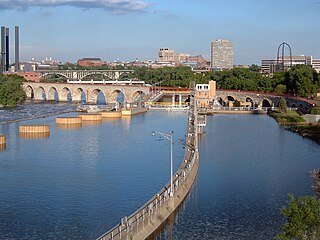
Transportation in the U.S. State of Minnesota consists of a complex network of roadways, railways, waterways and airports. The transportation system is generally overseen by the Minnesota Department of Transportation, a cabinet-level agency of the state government. Additionally, regional governments such as the Metropolitan Council have authority over regional planning for the transportation system and local governments such as cities and counties oversee the local transportation network.

Gaviidae Common is a mixed-use shopping mall and office complex on Nicollet Mall in Minneapolis, Minnesota. The first phase of the mall, Gaviidae Common I, opened in 1989 and is adjoined to Gaviidae Common II by a series of skyways. Phase II opened in 1991. A joint venture designed by Argentine American architect César Pelli and Chicago-based Lohan Associates, the mall occupies 443,000-square-foot (41,000 m2) of retail and office space spread across five floors. Following the closure of the mall's food court and several tenants in 2013, the top three floors of Gaviidae Common II were converted into office and recreational space for the adjoining RBC Plaza.

U.S. Bank Stadium is an enclosed stadium located in downtown Minneapolis, Minnesota. Built on the former site of the Hubert H. Humphrey Metrodome, the indoor stadium opened in 2016 and is the home of the Minnesota Vikings of the National Football League (NFL); it also hosts early season college baseball games of the University of Minnesota Golden Gophers.
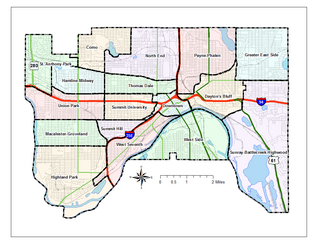
Saint Paul, Minnesota, consists of 17 officially defined city districts or neighborhoods.
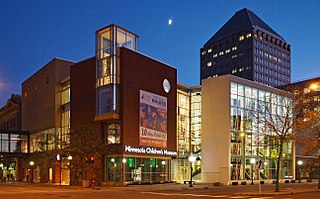
The Minnesota Children's Museum is a children's museum in Saint Paul, Minnesota. Founded in 1981 in Minneapolis, the museum moved to St. Paul in 1995.
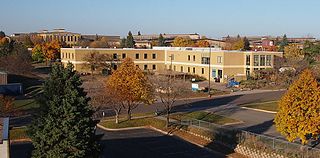
Energy Park is a mixed-use project in the Midway district of Saint Paul, Minnesota. It has industrial, commercial, and residential uses.

Minneapolis City Center is a mixed-use shopping mall on Nicollet Mall in Minneapolis, Minnesota. It opened in 1983 and occupies the bottom three floors of the 33 South Sixth office building. Designed by Skidmore, Owings & Merrill, Minneapolis City Center contains 250,000 square feet (23,000 m2) of leasable retail space. The mall was built around the pre-existing Forum Cafeteria restaurant. The building is adjacent to the Marriott Hotel City Center and connected to the Gaviidae Common shopping mall.

The FBI and ATF tracked 164 structure fires from arson that occurred May 27–30, 2020, during the George Floyd protests in Minneapolis–Saint Paul. Rioters started fires by igniting flammable materials within or next to buildings and in some cases by deploying Molotov cocktails. Property locations were damaged by spreading flames, heat, and smoke, and by suppressant waters from fire hoses and fire sprinkler systems. Many of the impacted structures suffered heavy damage or were destroyed, with some being reduced to piles of rubble after collapsing.
Hamline-Midway, or just Midway, is a neighborhood and city planning district in Saint Paul, Minnesota, in the United States. It is Planning District 11. The neighborhood is bounded by Transfer Road on the west, University Avenue on the south, Lexington Parkway on the east, and by the railroad tracks just north of the Pierce Butler Route, on the north. The unofficial boundaries are more loosely defined, however, and the term "Midway" is applied throughout this part of Saint Paul, often well beyond the actual location of the district. The 'Midway' name comes from being midway between downtown Minneapolis and downtown Saint Paul.

The Spruce Tree Centre is a building in Saint Paul, Minnesota, United States. Located at the intersection of University Avenue and Snelling Avenue, the 126,000 square feet (11,700 m2) building was built in 1988. An attached parking garage has over 350 spaces. The parking garage is owned by the city of Saint Paul and has electric car chargers. The building replaced a drug store built in the 1920s.
























